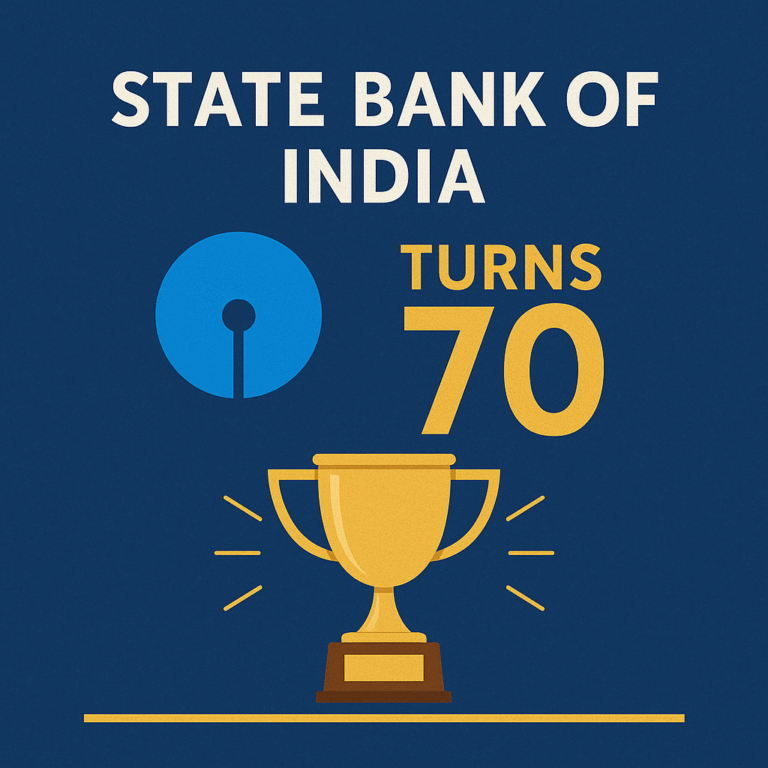As the State Bank of India (SBI) turns 70, it marks seven decades of trust, transformation, and excellence in the Indian banking sector. Born on 1 July 1955, following the nationalization of the Imperial Bank of India, SBI has grown into the largest commercial bank in the country.
The roots of SBI can be traced even further back to the Bank of Calcutta, established in 1806. Over the years, through several mergers and structural changes, the bank evolved into an institution that touches every Indian’s life.
🚀 Growth Story as State Bank of India (SBI) Turns 70
When the State Bank of India (SBI) turns 70, it celebrates its journey from a colonial-era institution to a global banking powerhouse. With assets exceeding ₹60 lakh crore and a customer base of over 50 crore, SBI commands over 20% of the Indian banking sector.
SBI has led the financial inclusion mission with:
Opening over 48 crore Jan Dhan accounts
Expanding rural and semi-urban banking
Digital innovations like YONO app, SBI Buddy, and SBI Quick
🌍 Global Presence: SBI Beyond Borders
As the State Bank of India (SBI) turns 70, it’s not just a national bank—it’s a global brand. SBI operates in 32 countries across 6 continents, making it India’s most visible financial institution on the world map.
Notable overseas locations:
USA (New York, Chicago)
UK (London)
Canada (Toronto)
UAE (Dubai)
Singapore, Hong Kong, Mauritius, South Africa
💻 Technological Transformation
The State Bank of India (SBI) turns 70 with a focus on digital banking:
YONO App: Over 60 million downloads
AI & Automation: Voicebots, chatbots, fraud detection
eKYC & Digital Lending: Reduced onboarding time from 3 days to 30 minutes
These advancements ensure SBI remains future-ready in an evolving fintech landscape.
👨🎓 SBI’s Role in Financial Literacy & Education
One reason why the State Bank of India (SBI) turns 70 as a symbol of trust is its active role in financial literacy, particularly:
SBI Youth for India Fellowship
Financial literacy camps in rural India
Dedicated initiatives for students and pensioners
🏅 Awards & Recognition
As the State Bank of India (SBI) turns 70, it has been honored with:
“Bank of the Year – India” by The Banker (2023)
Ranked among Fortune 500 companies
Consistent recognition for CSR, sustainability, and innovation
🎯 What the Future Holds
While the State Bank of India (SBI) turns 70, it’s preparing for a bold new era:
Emphasis on green financing and ESG lending
Expansion of AI-based decision-making systems
Greater presence in global capital markets
SBI is not just looking back on a glorious past but also forward to a transformative future.
🏛️ Evolution Timeline of SBI
| Year | Milestone |
|---|---|
| 1806 | Bank of Calcutta (India’s first bank) |
| 1921 | Formation of Imperial Bank of India |
| 1955 | Nationalization & renamed as State Bank of India |
| 2008–2017 | Merger with associate banks & Bharatiya Mahila Bank |
| 2025 | State Bank of India (SBI) turns 70 with global recognition |
Q1. When was the State Bank of India founded?
A: SBI was formed on 1 July 1955, after nationalizing the Imperial Bank of India.
Q2. Why is SBI called the backbone of Indian banking?
A: Because it leads in rural outreach, financial inclusion, and digital banking services across India.
Q3. Who is the current Chairman of SBI (2025)?
A: Dinesh Kumar Khara.
Q4. How is SBI celebrating its 70th anniversary?
A: Through customer engagement drives, financial literacy campaigns, and expansion announcements.
🔚 Final Thoughts
As the State Bank of India (SBI) turns 70, it reflects the journey of India’s economy itself—from colonialism to digitalization. With unmatched scale, deep rural roots, and futuristic vision, SBI continues to be “The Banker to Every Indian.”
Whether you’re a student, entrepreneur, salaried professional, or pensioner, chances are SBI has touched your life. The story of the State Bank of India (SBI) turning 70 is a celebration of Indian resilience, innovation, and inclusive growth.


My wife and i ended up being now lucky that Louis managed to conclude his inquiry through the ideas he received out of the web page. It’s not at all simplistic to simply happen to be handing out tips and tricks which usually a number of people may have been making money from. And we already know we have the writer to appreciate because of that. Those explanations you made, the easy web site menu, the relationships you aid to promote – it’s everything overwhelming, and it’s leading our son and us know that the concept is interesting, and that’s particularly serious. Thank you for the whole lot!